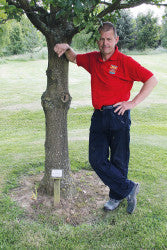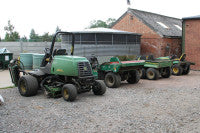Frank Kempster - in his father’s footsteps at Glen Gorse

When you've been at the same place for close on forty-seven years - apart from a couple of years out to try "something else", and your formative years were spent working under your father, it is safe to say that Francis (Frank) Kempster knows his course better than most course managers.
Frank began work at Glen Gorse Golf Club in 1965, where his father Reg was course manager. Prior to that he had helped out on the course whilst completing his schooling so, as Pitchcare magazine celebrates its fiftieth issue, it seems fitting that a man who has been part of the fabric of the club for fifty years, should feature.
Glen Gorse is an attractive, mature parkland course, not long by modern standards at 6,648 yards (par 72) from the medal tees, but considered as one of the more exacting tests of golfing ability in Leicestershire. The strategically placed trees encountered on every hole - many planted by Frank and his father - means that a premium is placed on accuracy, with the straight hitter gaining most reward.

Frank retains an enthusiasm for the job which becomes evident during our course walk. "Dad loved planting trees," says Frank proudly. "He was head greenkeeper here from 1958 until 1987 when he retired, so most of them have now reached maturity. It's something I continue to do, planting a few more every year. They form an integral part of the course, lining the fairways and surrounding the greens, but also give great cover for wildlife."

Frank, and his team of Craig Watt (his deputy), Oliver Gilbert, James Whitehead, Chris Shuttlewood and Michael Hood, have to work with soil push up greens but, he says, they are consistent, retain a good healthy colour and play extremely well.

"I report to the Course Committee on a regular basis, but I'm very much in control of what happens out on the course in terms of managing the day to day working regimes," he explains.
Greens are cut at 4mm in the summer and 6mm during the winter months, whilst tees (12mm) and fairways (16mm) are kept at the same height all year round, with the semi-rough kept at 25mm and the rough at 50mm, cutting as required.

"The greens are renovated in late summer, usually early September, to take advantage of the warm temperatures for seed germination," continues Frank. "All the greens are scarified with a Sisis R600 in several directions to a depth of between 10mm-20mm, topdressing with about one tonne of Leighton Buzzard sand. During the growing season (April - September), Frank applies a Banks 80/20 fen dressing to help keep the surfaces smooth and remove a bit of organic matter."

"Being soil push up greens, they tend to hold on to moisture quite well and have a fairly good cation exchange capacity, so they require less feeding than perhaps at other courses. We get through a lot of Headland Amenity product though, as I tend to put a light granular on once a month at the same time as the topdressing. I also apply their Clipless growth regulator on a monthly basis - mixed with their Proturf seaweed product - and Tricure wetting agent to help maintain even growth. Surrounds, approaches and
tees are treated similarly.".
T

The course has fifty-two bunkers, providing plenty of work for the greens staff. They are raked daily and the edges are trimmed with a brushcutter as required. Holes are changed regularly to cope with the golf traffic, and litter bins and tee markers are emptied and moved daily.

Conservation plays an important part in Frank's maintenance regimes and he works very closely with conservation groups with regard to tree preservation and managing the course. He says that it is all about creating a wildlife corridor within a golfing environment.
Frank is very keen on greenkeeper training and ensures that all his staff are trained in all aspects of greenkeeping skills. They attend NVQ level courses at Myerscough College, and he currently has two members of staff - Michael and Oliver - being assessed at the college for their level three diploma.
"T

"We have rolling programmes through the winter months of bunker refurbishments, i.e. drainage and redesigning them, plus tee levelling and enlarging,"

When we went on to an automatic system, the reservoir was left to silt up and over grow. Now, with having irrigation on greens, tees and approaches, we are using a lot of mains water. So, we want to open up the old reservoir to help cut down on our water bill but, as with most members clubs nowadays, it's the cost of getting it done that is the main stumbling block."
As we completed our course walk I was able to have a chat with a number of members, including the Lady Captain Carole Allsop and Course Chairman Alistair Sutton. All, without exception, were very complimentary about the greens staff and the condition of the course. So, credit where it's due. It seems Frank is managing his course very well. I am sure his dad would be very proud.

At Glen Gorse we have three five year machinery renewal plans all maturing at different intervals to spread the cost.
The majority of our machinery is John Deere as this suits our finances and the majority of the mowing we have to carry out.
John Deere 2500E greens mower x 1
John Deere 2500D tees & surrounds mower x 1
John Deere pedestrian greens mowers x 3
John Deere 2653B semi rough mower
John Deere 3235D fairway mower
Toro 4000D rough mower
John Deere 4700 tractor
John Deere 4520 tractor
John Deere 495 rotary mower
Hayter rotary mowers x 3
Flymo hover mowers x 3
Sisis R600 deep scarifyer
Sisis variseeder
Sisis maxislit slit tiner
Sisis fine turf slit tiner
Wiedenmann TerraSpike
Ancient Cushman and Cushman 1500 topdresser
Hardi 400 amp three point linkage sprayer
Set of Greentek verticutters for JD 2500
Set Greentek vibro rollers for JD 2500
Tomlin three point linkage mole plough
Stihl Chainsaws x 3
Maruyama & Stihl Strimmers x 3
Maruyama Hedgetrimmer
Stihl Hedgetrimmer
Team photo caption: L-r: Francis Kempster, Course Manager; Simon Dadge, Myerscough College assessor; Assistant Greenkeepers Michael Hood, Oliver Gilbert and James Whitehead; Craig Watt, Deputy Course Manager; Christopher Shuttlewood, 1st Assistant and Mechanic
